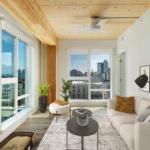Solution Papers
Mass Timber in Affordable Multi-Family Housing
A blueprint for design
Design steps, code compliance options, and material optimization strategies for those looking to utilize mass timber in affordable housing projects.

Mass timber has been successfully used in projects of all sizes, ranging from luxury to market rate to affordable. U.S. developers have built mass timber housing for residents making as low as 25% of the area median income (AMI), and there are numerous projects that include both market rate and affordable units. For mass timber to be cost competitive in this multi-family sub-segment, design efficiency, material optimization, and a wholistic understanding of where savings may lie are especially important. The potential benefits of a mass timber structural system include:
- Sustainability: Wood products have low embodied carbon compared to other building materials, which means they cause fewer greenhouse gas emissions throughout their life cycle. Mass timber also continues to store carbon absorbed by the trees while they were growing. Low embodied carbon + stored carbon = lower carbon impact.
- Labor savings. Projects located where on-site labor costs are high can benefit from the smaller crews and faster installation associated with mass timber construction.
- Foundation savings. For sites with poor soil conditions, mass timber can reduce foundation costs due to its light weight, especially when compared with a full concrete structure.
- Occupant wellbeing. The aesthetic of exposed wood can be part of a biophilic design strategy, which prioritizes occupant wellbeing through a connection to nature and the use of natural materials.
- Reduced height. Mass timber floor systems can result in thinner structure depths when spans are optimized and beams and headers are minimized within units. The reduced depth can translate to higher ceiling heights, or more commonly in affordable housing projects, shorter floor-to-floor heights (while maintaining an 8-foot or greater ceiling height). Shorter floor-to-floor heights result in a shorter overall building, which reduces costs associated with all vertical systems—e.g., exterior enclosure and facades, interior partitions, elevators and shafts, and mechanical, electrical, plumbing, and fire protection (MEPF). This can significantly influence the overall cost feasibility of using mass timber in an affordable housing project.
- Differentiated product. Developers may also select mass timber for its ability to create market differential, which can lead to enhanced leasing velocity, lower tenant turnover, higher building value at exit, and other economic benefits.
 340+ Dixwell – New Haven, CT / GOA |  Railyard Flats – 605 Creative Co., courtesy Co-Op Architecture |
This paper focuses on three structural typologies at the following size and scale:
- Small – low-rise – 1-3 stories
- Medium – mid-rise – 4-8 stories
- Large – high-rise – 9+ stories
To help project teams align their goals and design decisions with the capabilities of mass timber, WoodWorks developed the Mass Timber Cost and Design Optimization Checklists. This paper builds on that resource with a framework of design steps, code compliance options, and material optimization strategies for those looking to utilize mass timber in affordable housing projects. While there are differences in how luxury and market rate housing is designed, the framework may also be useful for those projects as the code compliance path and material optimization methods are nearly identical.
Common Structural Typologies
Mass timber refers to a category of framing styles characterized by the use of large engineered wood panels, often paired with engineered wood columns and beams. Panels are most frequently used in horizontal applications for floors and roofs, but can also be used vertically for walls. Products referred to in this paper include cross-laminated timber (CLT), glue-laminated timber (glulam or GLT), dowel-laminated timber (DLT), and nail-laminated timber (NLT). The systems most commonly used in multi-family projects can be consolidated into three categories:
- Mass timber floors and roofs on mass timber bearing walls
- Mass timber floors and roofs on light-frame bearing walls (wood or steel)
- Mass timber floors and roofs on post-and-beam framing
 Chiles House – Portland, OR / All Hands Architecture |  Timberview – Portland, OR / Access Architecture |
Download this free paper for 18 more pages of content, including examples of affordable housing projects across the country, as well as guidance on topics such as:
- Construction Type Options and Fire-Resistance Rating, including exceeding prescriptive height limits, FRR requirements and design impacts, FRR design of mass timber elements, and FRR design of light-frame wall assemblies
- Acoustic Performance, including designing mass timber floor panels for acoustics, designing mass timber wall panels for acoustic performance, acoustic design of light-frame wood wall assemblies, and detailing floor-to-wall intersections
- Structural Design of Mass Timber Floor Panels, including other MEPF integration options
- Lateral System Options
 | |
| See the projects and teams featured in this paper on the WoodWorks Innovation Network (WIN) | |
 | Heartwood – Seattle, WA Candlewood Suites – Huntsville, AL 340+ Dixwell – New Haven, CT Railyard Flats – Sioux Falls, SD Junction Lofts – West Des Moines, IA Chiles House – Portland, OR Star Lofts – Portland, OR Sonrisa – Sacramento, CA Bunker Hill Housing Building M – Charlestown, MA The Canyons – Portland, OR 1510 Webster – Oakland, CA |



